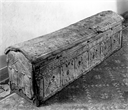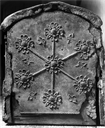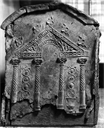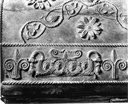| Showing 1 of 1 |
|
Sarcophagus with Architectural and Apotropaic Imagery
Roman
2nd century - 3rd century
55 cm x 173 cm x 41.2 cm (21 5/8 in. x 68 1/8 in. x 16 1/4 in.)
lead on wood
BZ.1941.2
On view
Permalink:
http://museum.doaks.org/objects-1/info/36588
Keywords
This object has the following keywords:
Colonnades,
Columns,
Dolphins,
Leaf-Like|Leaves,
Masks,
Medusa|Gorgon Medusa,
Six-Rayed,
Sphinxes,
Temples,
Vine Trellis
- Colonnades
- Columns
- Dolphins
- Leaf-Like|Leaves
- Masks
- Medusa|Gorgon Medusa
- Six-Rayed
- Sphinxes
- Temples
- Vine Trellis
Additional Images
Object Last Modified: 9/19/2024












